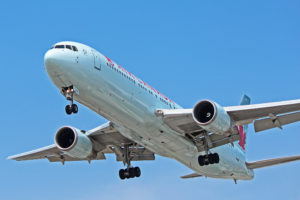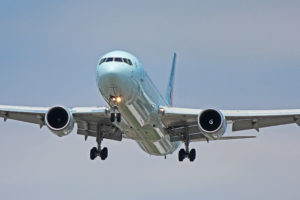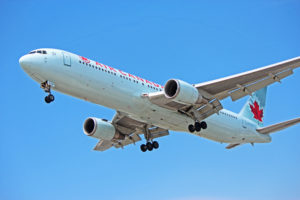 Its time in service is coming to a close. C-FTCA is one of nine Boeing 767-300ER aircraft in Air Canada’s main fleet and five are slated to be phased out by the end of 2018. With this being one of the oldest, entering service in 1989, this airplane may very well be going into its final year in the friendly skies. We photographed this particular airliner on July 20, 2017 while plane spotting at Toronto Pearson International Airport (YYZ).
Its time in service is coming to a close. C-FTCA is one of nine Boeing 767-300ER aircraft in Air Canada’s main fleet and five are slated to be phased out by the end of 2018. With this being one of the oldest, entering service in 1989, this airplane may very well be going into its final year in the friendly skies. We photographed this particular airliner on July 20, 2017 while plane spotting at Toronto Pearson International Airport (YYZ).
For full-size, high resolution versions of any of the photos in the image gallery, simply click on the individual pictures. See below for more detailed information on C-FTCA, the Boeing 767-300ER model in general and the airline.
Image Gallery
C-FTCA
Boeing 767-300ER
Air Canada
Resources
C-FTCA Air Canada Boeing 767-300ER Image Gallery
C-FTCA
C-FTCA took its maiden flight on April 11, 1989 and was first delivered to Canadian Airlines on April 25, 1989. On March 29, 2001, the Boeing 767-300ER was transferred to Air Canada after Canadian was merged into the larger airline. The aircraft is configured for a maximum total of 211 passengers with 24 seats in business class and 187 more in economy class. As mentioned, this is one of nine B763 aircraft still in the main Air Canada fleet with five of those nine to be phased out by the end of 2018.
Way back on September 6, 1997, on a flight from Beijing, China to Vancouver, British Columbia, C-FTCA ran into some engine trouble. As they were beginning the takeoff roll, a loud explosion was heard by the crew, followed by vibrations while the aircraft yawed to the left. The takeoff, of course, was rejected and the crew received a fire warning for the left side engine. The fire was extinguished and it was noted that parts from the high pressure compressor had detached from the engine.
On December 15, 2012, the Boeing 767-300ER was flying from Vancouver to Seoul, South Korea. Just southeast of Anchorage, Alaska, the crew inadvertently switched two of the three Inertial Reference Systems off. The aircraft was diverted to Anchorage for a safe landing. The Inertial Reference Mode Panel was replaced when it was noticed that the switches could be moved with little force.
On October 17, 2016, the B763 was flying from Toronto, Ontario to Montreal, Quebec. After being shaken by turbulence, two flight attendants were injured and were unable to continue their duties. It was later reported that the injuries were minor.
Boeing 767-300ER
The first Boeing 767-300ER entered service with American Airlines in 1988, seven years after the initial 767 variant came on the scene with United Airlines. In total, 583 of the 767-300ER models were delivered.
The aircraft is 55 metres or 180 feet in length with a wingspan of 48 metres or 156 feet. At the tail, the airliner stands 16 metres or 52 feet in height. The flight range is 11,070 kilometres.
Air Canada
Founded in 1937 as Trans Canada Air Lines, the airline officially commenced operations under the Air Canada name in 1965. Including subsidiaries Air Canada Rouge and Air Canada Express, the airline has a fleet of over 400 aircraft flying to 350 destinations worldwide. The largest in the fleet is the Boeing 777-300ER while the most numerous is the Airbus A320-200.
Headquartered on the grounds of Montreal Pierre Elliott Trudeau International Airport (YUL), Air Canada is a founding member of the Star Alliance. Other founding member airlines include Lufthansa, Scandinavian Airlines, Thai Airways and United Airlines. The alliance now has 27 full members around the world.
Resources




